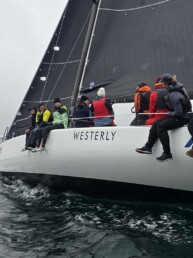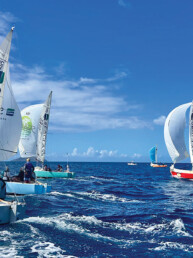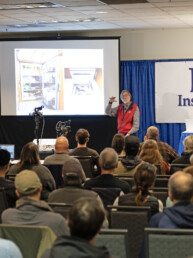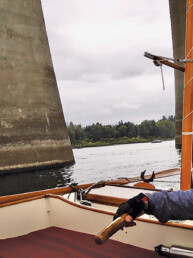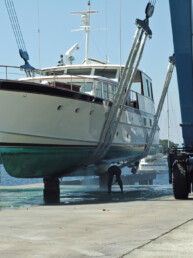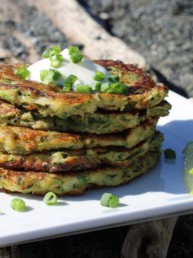This article was originally published in the November 2021 issue of 48° North.
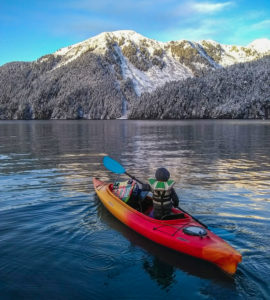 Snow and ice crunched under my sea boots while walking down D-dock towards Yahtzee’s slip in Seward Harbor. The boys were ahead of me and I could see from afar that the boat was covered in white beyond them. If we were going to set out on a winter cruise to cap off the year, we’d have to shovel off the decks and cockpit and chip ice away from the winches first.
Snow and ice crunched under my sea boots while walking down D-dock towards Yahtzee’s slip in Seward Harbor. The boys were ahead of me and I could see from afar that the boat was covered in white beyond them. If we were going to set out on a winter cruise to cap off the year, we’d have to shovel off the decks and cockpit and chip ice away from the winches first.
After a splendid Christmas celebration ashore and with a new year approaching, this would essentially be our first shakedown cruise in anticipation of departing Seward in the spring and exploring more of Alaska before sailing south for warmer climes. That being the case, while clearing snow off the boat, I couldn’t help but think back on the full year of boatwork that brought us to this point. It had been a long yet rewarding process.
Just a few months prior, we’d dropped a shiny new Beta 50 engine and saildrive in Yahtzee, and I smiled when she fired right up and purred on that cold December morning. Stepping down below to start our diesel heater, I looked around at freshly varnished woodwork, a bright new headliner, and more drawers for storage. Indeed, Yahtzee had almost become a new-to-us boat in the course of one year. With all that hard work behind us, though, it was time to get her out on the water for a few days of proper winter cruising to test her, and our, mettle.
Winter Wonderland
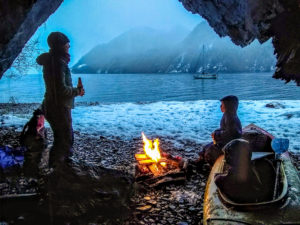
Nosing Yahtzee’s hull through a thin layer of ice, we were soon clearing the breakwater and heading south into open water. A biting northerly wind funneled from the nearby mountains down onto the bay and we set sail and settled in for a long broad reach to our first anchorage. It was cold, but worth it to be back out — and with gloved hands frozen to the helm, I allowed myself a brief moment to dream about anchoring off warm, palm tree lined beaches.
Only 3 miles wide, Resurrection Bay is flanked by steep mountains on either side and several days of fresh snow had added a thick blanket of white to the craggy peaks and steep valleys. With skis, as well as a snowboard and sled aboard, Porter and Magnus were eager to see what adventures could be had in this winter wonderland.
On December 27 at 60 degrees north, the days are short — with the sun rising at 10 a.m. and setting before 4 p.m. — and we dropped anchor as the last vestiges of light were fading. Fortunately, we had something to celebrate in the cozy warmth of the cabin. It was Magnus’ birthday and he excitedly blew out four candles and, among other gifts, tried on a new swimsuit that would come in handy several months and many miles down the road.
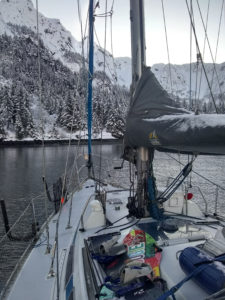
The following morning brought blue skies and, as daylight ever-so-slowly joined the party, we made our way on deck and formulated a plan to use every bit of it. Porter was soon off in the kayak with his sled, and the rest of us followed in the dinghy. While the boys rolled in the snow and slid down small hills, Jill and I walked the long rocky beach. We chatted about all that we’d accomplished in the past year and what our plans, hopes, and dreams were for the upcoming summer cruising season and then voyaging south.
From the beach, we spotted one of the bay’s public use cabins tucked amongst the woods and motioned the boys to follow along to see if it was occupied. As expected, it sat empty and we decided to use it as a warming hut for the day. Accordingly, I got a fire going in the wood stove while Jill paddled back to the boat to collect beverages and the makings for soup to cook on top. With the little cabin warming, we shed wet layers, gloves and hats and hung them by the heating stack to dry.
Slurping hot soup and drinks, we played cards in the dim light until, just as slowly as the sun had come, it began to fade, letting us know we needed to make our way back to Yahtzee.
A far cry from the long days and nights of summer at this latitude, the contrast between the seasons made us appreciate just how remarkably unique cruising is in this part of Alaska anytime of year.
Fox Island Intrigue
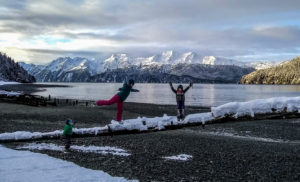 After a couple days of this blissfully similar, lazy routine, we decided to try one more anchorage before heading back to the marina and sailed a few miles south to Sunny Cove on Fox Island. Gone were the sunny skies we’d had, only to be replaced with a bruise-colored cloudiness that made the days darker, the threat of more snow imminent, and the solitude seem more palpable.
After a couple days of this blissfully similar, lazy routine, we decided to try one more anchorage before heading back to the marina and sailed a few miles south to Sunny Cove on Fox Island. Gone were the sunny skies we’d had, only to be replaced with a bruise-colored cloudiness that made the days darker, the threat of more snow imminent, and the solitude seem more palpable.
Relatively small in overall size, rugged Fox Island is diverse in its terrain with a flat, rocky spit at the northeastern end and two coves on the western side. Between them are tall, spruce covered mountains that, on this day, pressed skyward into the low clouds. Passing Halibut Cove to the
north first, we rounded the corner into Sunny Cove with a whisper of snow falling on flat water that emanated a breathtakingly peaceful scene.
Besides cabins and a day lodge in Halibut Cove that are primarily used in the summers, Fox Island is uninhabited and holds an interesting history. In 1918, a prominent artist from New York named Rockwell Kent came to Alaska with his young son — also named Rockwell — to live in the wilderness and revitalize his creativity through his painting. Arriving in Seward by steamship from Seattle with no plan, the pair acquired an 18-foot dory, loaded it with their personal effects and provisions, and set out for a place called Fox Island — which they had only recently heard about from locals in town.

Landing on Fox Island, they met an old Swede named Olson who was the sole inhabitant and caretaker of a working fox farm that was leased from the government. While showing them around the island, he encouraged the father and son duo to fix up an empty cabin and spend the winter there; and in doing so, he became the pair’s wilderness mentor. Among the supplies they brought with them were painting canvases, paint, and a collection of books that included Nietzsche’s Thus Spoke Zarathustra, Homer’s Odyssey and Iliad, Daniel Defoe’s Robinson Crusoe, and a tome called Northern Mists, which was penned by Norwegian explorer Fridtjof Nansen. The latter would prove inspiring
to Kent’s own writing.
The winter of 1918-1919 was a harsh one on Fox Island and, beyond the hardships and loneliness, Rockwell described a snowy, secluded paradise that captivated his senses as a landscape painter. While Kent didn’t fancy himself a writer, he spent many nights drafting lengthy, eloquent, and detailed letters to his wife and friends describing the Alaskan wilderness and its many moods.
Later, when he returned home to the east coast, those letters became the basis of a book titled, Wilderness: A Journal of Quiet Adventure in Alaska. Considered a forgotten classic of nature writing with beautiful illustrations by Kent, he provides a graceful, vivid, and genuinely factual look at what life was like on the island and the highs and lows that came with living in the wilds of Alaska.
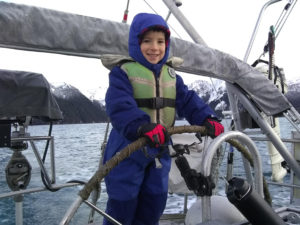 Having read the book just prior to arriving on Fox Island on that snowy December day, I thought deeply about what it must have been like to live here throughout the winter. Sure, I wasn’t showing up on an 18-foot dory loaded with many months of supplies, quite the opposite. But, at that moment, being the only people on the island, I could grasp what Olson and the Kents must have endured and come to enjoy in this desolate wilderness. Though their documented hardships were real,
Having read the book just prior to arriving on Fox Island on that snowy December day, I thought deeply about what it must have been like to live here throughout the winter. Sure, I wasn’t showing up on an 18-foot dory loaded with many months of supplies, quite the opposite. But, at that moment, being the only people on the island, I could grasp what Olson and the Kents must have endured and come to enjoy in this desolate wilderness. Though their documented hardships were real,
he also described times of immeasurable beauty and tranquility that so many people seek when taking on such a grand and bold adventure.
While peering out of a cave at the southern end of the cove, a fire crackled before me and snow fell heavily from the sky onto the trees and beach, and into the water. Jill and I looked on at the scene while the boys sat quietly sipping hot cocoa, and it felt like we were the only people in the world. I’m guessing Rockwell Kent had some of these same feelings 100 years earlier when he’d written, “These are the times in life — when nothing happens — but in quietness the soul expands.”
New Year, New Journeys
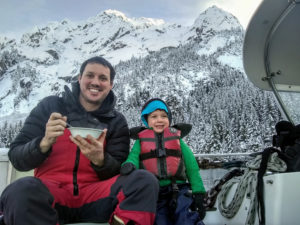
We weighed anchor the following morning on New Year’s Eve and sailed the 12 miles from Fox Island back to Seward. An exuberant pod of porpoises played on the bow along the way and I could feel a similar energy from our crew. When we tied up in our slip and stepped back onto the snowy dock, it was with an immense sense of accomplishment and optimism. Though difficult at times, it had been a successful shakedown and an equally rewarding cruise. Similar to our winters spent cruising the Salish Sea, our experience had delivered an almost unimaginable amount of solitude like few other places on earth can.
The new year dawned with a list of fresh boat projects to tackle and a date set for departure back into full-time cruising. In the moment, it felt as though our family and Yahtzee were being set onto our proper course. When I think back on that year-end cruise and all the work we’d done leading up to
it, I realize that it turned out to be the perfect way to connect with one another around the holidays, reflect on an incredible year in Alaska, and get geared up for the voyages and adventures ahead.
Andy Cross
Andy Cross is the editor of 48° North. After years cruising the Pacific Northwest and Alaska with his family aboard their Grand Soleil 39, Yahtzee, they sailed south and are currently in the Caribbean Sea. You can follow their adventures at SailingYahtzee.com.

